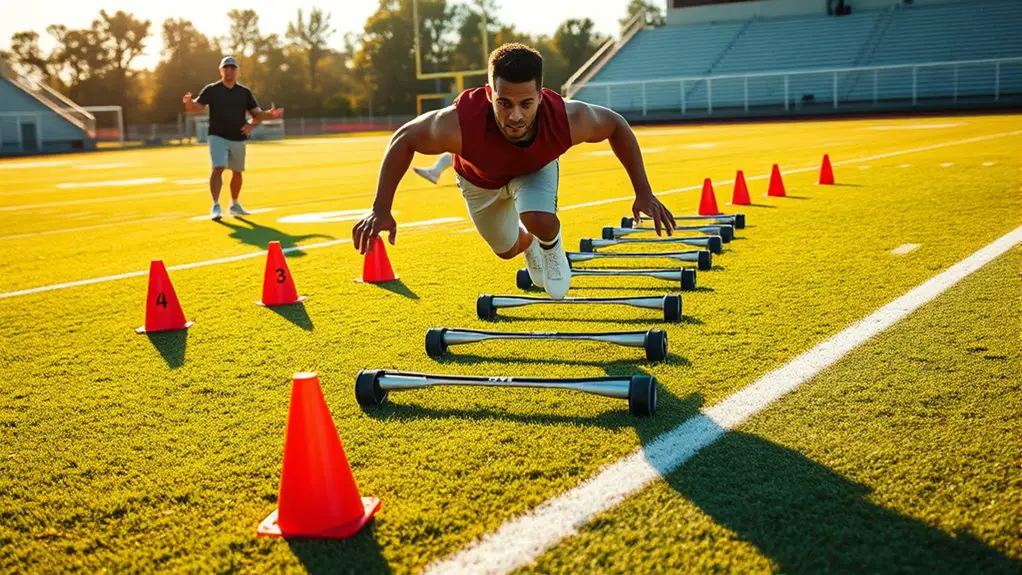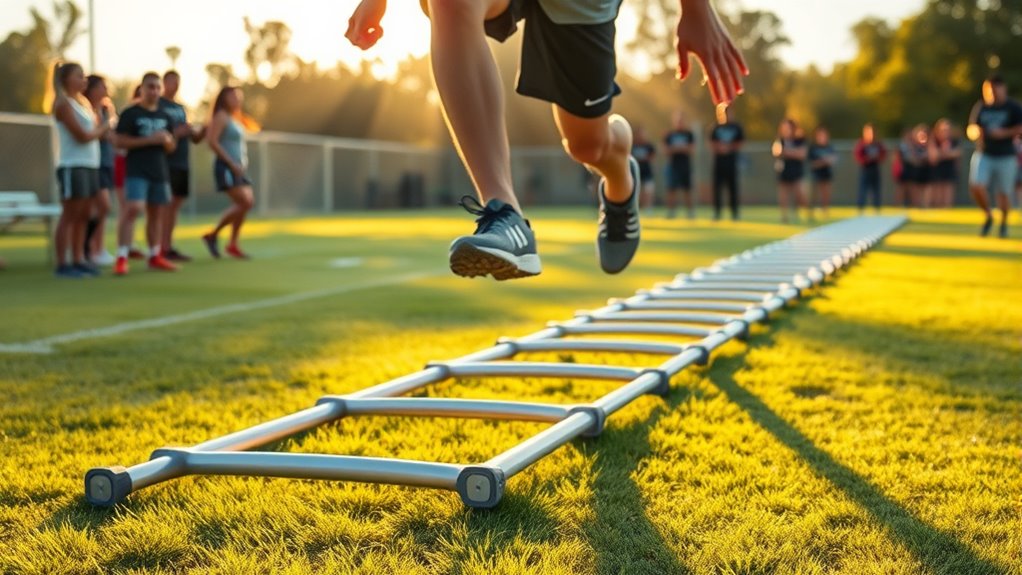To improve your balance and agility as a running back, focus on core strength exercises like planks and Russian twists. Add footwork drills, such as ladder and cone drills, to enhance your quickness and control. Incorporate plyometric techniques, like box jumps, for explosive movement. Don't forget flexibility training to improve your range of motion and reduce injury risk. Each of these elements plays an essential role in your performance. There's much more to explore that can elevate your game even further.
Understanding the Importance of Balance and Agility
When you consider the demands placed on running backs in football, it's clear that balance and agility aren't just skills; they're essential for success. You need to master balance techniques to navigate through tight defenses and make quick cuts without losing momentum. This doesn't mean you have to be stiff—embrace fluidity in your movements to maintain your freedom on the field.
Agility benefits extend beyond just dodging tackles; they empower you to create explosive plays and evade defenders with ease. By honing your balance, you'll find that your body responds instinctively, allowing for faster acceleration and sharper turns. Incorporating agility training techniques that focus on these core elements will elevate your game. Think of balance as your foundation and agility as the wings that let you soar. Together, they'll help you break free, turning every play into an opportunity for greatness.
Core Strength Exercises for Enhanced Stability
To enhance your stability on the field, incorporating core strength exercises into your training regimen is essential. Focusing on core engagement not only improves your balance but also empowers you to maneuver effectively during the game. Here are some effective exercises to evaluate for your stability training:
| Exercise | Benefits |
|---|---|
| Plank | Builds overall core strength |
| Russian Twists | Enhances rotational stability |
| Dead Bug | Improves coordination and control |
| Side Plank | Strengthens obliques for balance |
Make these exercises a regular part of your workouts, and you'll notice a significant improvement in your stability. When you master core engagement, you'll feel more grounded and agile, ready to take on any challenge on the field. Embrace these exercises, and watch your performance soar! Additionally, developing a strong core helps prevent injuries, allowing for unrestricted physical pursuits and enhancing movement efficiency.
Footwork Drills to Improve Quickness and Control
Improving your footwork is essential for running backs looking to enhance quickness and control on the field. By focusing on foot placement and lateral movement, you can create a solid foundation for your agility. Here are three drills to incorporate into your training:
- Ladder Drills: Use an agility ladder to work on quick foot placement. Focus on stepping in and out of each square, varying your speed and direction.
- Cone Drills: Set up cones in a zigzag pattern. Practice quick changes in direction, emphasizing sharp cuts and maintaining control throughout your lateral movement.
- Dot Drills: Mark five points in a cross pattern. Jump from dot to dot, working on your landing and ensuring your foot placement is precise.
Incorporating agility ladder drills into your routine will sharpen your footwork, giving you the freedom to navigate the field with confidence and agility.
Plyometric Techniques for Explosive Movement
Plyometric techniques can markedly boost a running back's explosive movement, crucial for breaking tackles and accelerating past defenders. Incorporating bounding exercises into your routine can really enhance your power. These movements mimic the action of running but with a focus on maximizing distance and height, allowing you to develop that explosive push-off. Jump training is another essential component. You can perform box jumps or depth jumps to build strength in your legs while improving your overall agility. Focus on quick, powerful movements that engage your fast-twitch muscle fibers, as they're key to generating explosive speed. Additionally, training to improve neuromuscular control enhances your ability to make rapid directional changes during gameplay.
Agility Ladder Drills for Precision and Speed
Agility ladder drills are a game-changer for running backs looking to enhance their precision and speed on the field. By incorporating ladder variations into your training, you'll boost your footwork and sharpen your agility. Here are three effective drills to get you started:
Agility ladder drills transform running backs' precision and speed, enhancing footwork and agility for improved on-field performance.
- Basic In-and-Out: Step in and out of each square, focusing on quick foot strikes. This builds balance and coordination.
- Lateral Shuffle: Move sideways through the ladder while maintaining a low stance. This drill improves your lateral speed and quickness.
- Single-Leg Hops: Hop through the ladder on one leg, then switch. This will challenge your stability and promote speed enhancement.
These drills not only get your heart pumping but also refine your movements, giving you the freedom to navigate through defenses with confidence. Additionally, improving your core strength will further support your overall balance and stability during these drills. Embrace these exercises, and watch your performance soar!
Incorporating Balance Boards Into Your Training Routine
After mastering agility ladder drills, adding balance boards to your training can take your skills to the next level. Balance board techniques enhance your core strength and coordination, allowing you to feel more in control during dynamic movements. These boards challenge your stability, simulating the unpredictable nature of a game, which is essential for running backs like you.
Incorporating them into your routine offers stability training benefits that can't be ignored. Start with simple exercises, like standing on one foot or performing squats while maintaining balance. As you progress, try dynamic movements, such as lateral shifts or single-leg hops. Engaging in mobility training can further improve your overall performance and reduce your risk of injury.
The more you practice, the more agile and balanced you'll become, giving you that freedom to maneuver past defenders effortlessly. Remember, consistency is vital—make balance board training a regular part of your regimen, and watch your performance soar on the field.
The Role of Flexibility in Agility Training
While you might think of strength and speed as the cornerstones of agility training, flexibility plays a crucial role in enhancing your overall performance as a running back. By incorporating dynamic stretching and mobility routines into your training, you can reveal your body's full potential. Here's how flexibility supports your agility:
- Improved Range of Motion: Increased flexibility allows for greater movement, enabling quick cuts and turns necessary for evading defenders.
- Reduced Injury Risk: Flexible muscles and joints are less prone to strains and tears, keeping you on the field longer.
- Enhanced Balance: A flexible body can adjust better to sudden shifts in weight, helping you maintain balance during dynamic plays.
Incorporating mobility training into your routine not only enhances flexibility but also elevates your overall athletic performance. Embrace flexibility as a key element in your training, and you'll experience newfound freedom and agility on the field. Remember, it's not just about strength—it's about fluidity in every movement.
Frequently Asked Questions
How Does Diet Impact Balance and Agility Training?
Diet plays an essential role in your balance and agility training. With proper nutrient timing, you can fuel your body effectively, ensuring you've got the energy to perform at your best. Additionally, hydration strategies are important; staying well-hydrated helps maintain focus and coordination during workouts. So, by paying attention to what you eat and drink, you'll find that your training becomes more effective, giving you the freedom to excel in your performance.
What Role Does Mental Focus Play in Improving Agility?
Mental focus plays a huge role in boosting your agility. When you harness mental visualization, you can picture yourself moving fluidly and quickly, enhancing your physical performance. Concentration exercises can sharpen your mind, helping you react faster on the field. By staying present and focused, you free yourself from distractions, allowing your body to respond instinctively. Embracing this mental aspect can elevate your agility and overall performance in ways you may not have imagined.
Can Specific Footwear Enhance Balance for Running Backs?
Sure, because who needs balance when you can just wear the fanciest shoes, right? But seriously, specific footwear can greatly enhance your balance. Look for shoes that offer solid footwear stability and sole flexibility, allowing your feet to move naturally while maintaining support. With the right kicks, you'll feel like you can dance on a tightrope. So, invest wisely—your feet will thank you when you're dodging tackles and showcasing your agility!
How Often Should Agility Training Be Incorporated Into a Routine?
When it comes to agility training, frequency recommendations suggest incorporating it into your routine at least two to three times a week. This keeps your skills sharp without overwhelming your body. Adjust your training schedules based on your overall fitness goals and how your body feels. Consistency is key, but don't forget to listen to yourself. You want to enjoy the process while improving, so find a balance that works for you!
Are There Age-Related Considerations for Balance Training?
When considering balance training, age-related factors are essential. In youth training, you can focus on foundational skills and dynamic movements that promote coordination. As you age, though, you might need senior modifications to guarantee safety, like low-impact exercises and stability work. It's all about finding what feels right for you at each stage of life, so you can enjoy the freedom of movement without risking injury or discomfort.




